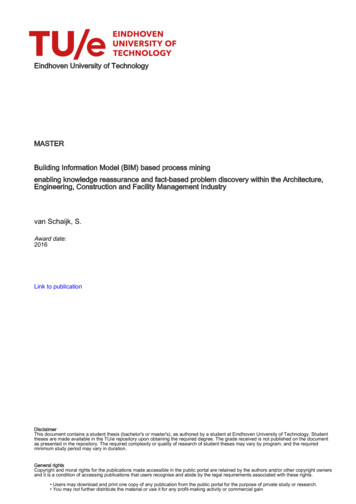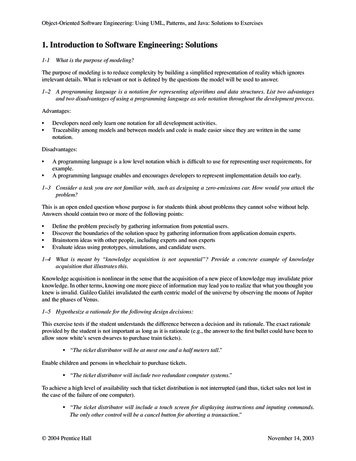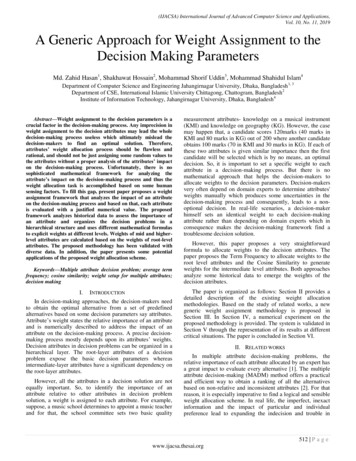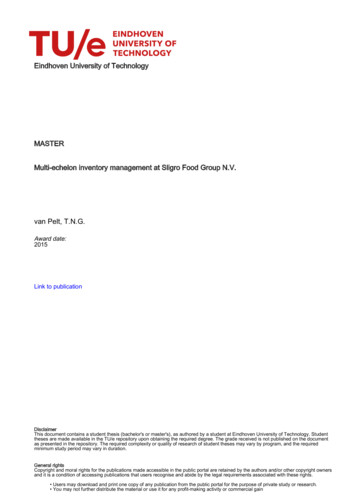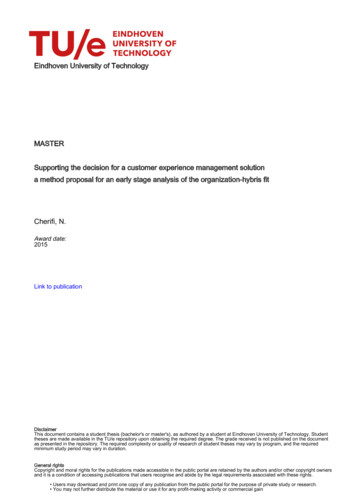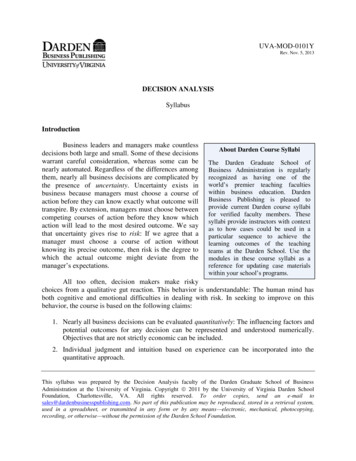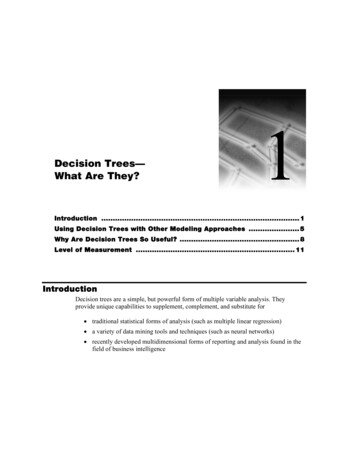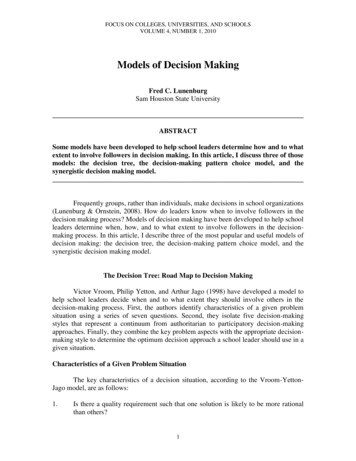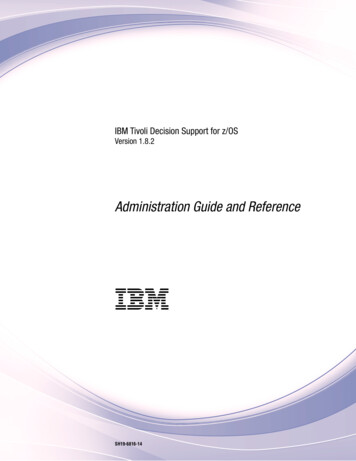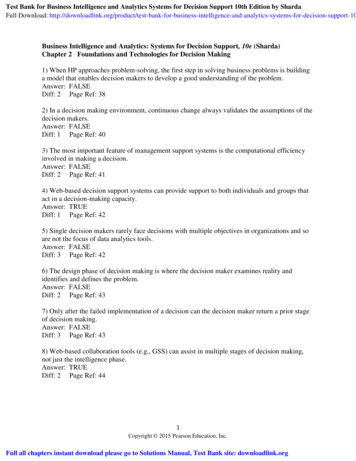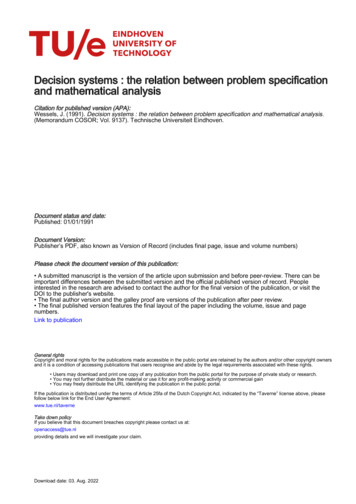
Transcription
Decision systems : the relation between problem specificationand mathematical analysisCitation for published version (APA):Wessels, J. (1991). Decision systems : the relation between problem specification and mathematical analysis.(Memorandum COSOR; Vol. 9137). Technische Universiteit Eindhoven.Document status and date:Published: 01/01/1991Document Version:Publisher’s PDF, also known as Version of Record (includes final page, issue and volume numbers)Please check the document version of this publication: A submitted manuscript is the version of the article upon submission and before peer-review. There can beimportant differences between the submitted version and the official published version of record. Peopleinterested in the research are advised to contact the author for the final version of the publication, or visit theDOI to the publisher's website. The final author version and the galley proof are versions of the publication after peer review. The final published version features the final layout of the paper including the volume, issue and pagenumbers.Link to publicationGeneral rightsCopyright and moral rights for the publications made accessible in the public portal are retained by the authors and/or other copyright ownersand it is a condition of accessing publications that users recognise and abide by the legal requirements associated with these rights. Users may download and print one copy of any publication from the public portal for the purpose of private study or research. You may not further distribute the material or use it for any profit-making activity or commercial gain You may freely distribute the URL identifying the publication in the public portal.If the publication is distributed under the terms of Article 25fa of the Dutch Copyright Act, indicated by the “Taverne” license above, pleasefollow below link for the End User Agreement:www.tue.nl/taverneTake down policyIf you believe that this document breaches copyright please contact us at:openaccess@tue.nlproviding details and we will investigate your claim.Download date: 03. Aug. 2022
TECHNISCHE UNIVERSITEIT EINDHOVENFaculteit Wiskunde en InformaticaMemorandum COSOR 91-37Decision systems; the relation between problemspecification and mathematical analysisJ. WesselsEindhoven University of TechnologyDepartment of Mathematics and Computing ScienceP.O. Box 5135600 MB EindhovenThe NetherlandsEindhoven, December 1991The NetherlandsISSN 0926-4493
Decision Systemsthe relation between problemspecification and mathematical analysisJaap WesselsInternational Institute for Applied Systems AnalysisLaxenburg, AustriaTechnical University EindhovenEindhoven, The NetherlandsAbstractIn this paper it is demonstrated that automated support for decision making ofa tactical or strategic nature requires a solver-independent medium for describing decision situations. Such a medium may be specificfor one environment, but it is also possible to develop media for certain types ofenvironments. By using such a medium one obtains a decoupling of problem formulation and method of analysis. This makes it possible to use (parts of) the problemformulation as input for different types of models. Such problem formulations mayprovide mathematical models themselves, although they might also contain someless formal features.The decoupling makes it possible to choose problem formulations which aremuch closer to the original decision situation than would otherwise be possible withformulations in terms of a preselected solver. The argumentation is illustrated bytreating a language for specifying goods flow problems in some detail. This languageis based on timed coloured Petri-nets.1Introduction.The present paper is based on two types of experiences. In the first place the experiencethat only in exceptional cases the step from the decision situation to a mathematicalmodel is a simple and natural one. A case where the step is relatively natural is theproblem of routing and loading of trucks for the distribution of baking flour from themill to the bakeries. Although, even in such a case, quite relevant constraints do notfit in the mathematical language. However, in most decision making problems the stepfrom problem to model is large and, usually, it is also one of the most essential steps in1
the development of decision support systems. In the second place, we have experiencedthat only for operational decision making does one encounter the situation that a fixedsequence of steps leads from problem to model. Only in operational decision making onesees that essentially the same problem recurs, only with different data. In tactical andstrategic decision making, however, one usually gets different types of problems subsequently, although they may use more or less the same data and other knowledge aboutthe functioning of the system.Example: a distribution structureIn order to keep a distribution structure in good shape in a changing world, one needsfrequent adaptations. That means that not only operational decisions have to be made,but also tactical and strategic questions arise frequently and because of the complexityof these questions it would be good to have some tools for supporting this tactical andstrategical decision making. However, the requirements for these tools are to be developedfor a loosely described set of questions. Only later the real questions and how theyare formulated appear. So, a main characteristic of pre-fabricated tools should be theirflexibility and adaptability with respect to the types of questions they can be used for.Let us list some of these questions regarding a distribution structure in order to get someidea about their diversity:a. Do we still need a distribution structure with three levels in a uniting Europe withhigher demands on speed and stronger price-competition?b. Do we produce all our products in each factory or will the distribution structure stillbe able to satisfy the performance requirements if the less demanded products areonly manufactured by one factory?c. If the factories specialize, is it then still necessary that each central warehouse storesall products or is it sufficient to forward the products only to the closest centralwarehouse (possibly located on the same premises as the factory)?d. Do we still need so many regional warehouses?e. Are the regional warehouses located in the right areas?f. From where does a warehouse get its products? Would it be better to keep fixed rulesfor this allocation or replace them by dynamic ones?g. How is the transport organised (frequent combined shippings, less frequent direct shippings or using an outside transport company)?h. How do we fit a new line of products into the system?i. How do we adapt the distribution structure after the merging with a regional competitorwho possesses his own distribution system?etc., etc.This example clearly shows how the same data and the same mechanisms with regardto production, distribution and demand form the basis for answering a great variety2
of questions. Most of these questions cannot be answered directly with the given dataand mechanisms, but require some form of advanced modelling and model analysis. Fordifferent questions one will need different types of models and different modes of analysis.For the location of facilities or allocation of production, linear programming might beuseful. However, for allocation of regional warehouses to central warehouses we needsome form of integer programming. For determining order levels, inventory theory will beuseful and for evaluating the time performance of (parts of) the system, a queueing modelmight be sensible. For detailed checking of proposed new structures, it will be necessaryto use simulation and scheduling models come in to mimic the daily operations. In fact,different questions of the types listed above will require non-standard models.If one wants to make a decision support environment for the type of situation as describedbefore, then the main arguments are time and money. "Time", since without a decisionsupport environment each new question would require a time consuming analysis whicheasily takes more time than available. "Money", because such complete decision analysesare expensive, they not only cost much time, but also many man-hours. So the mainreasons for investing in a decision support environment for tactical and strategic decisionmaking are the speeding-up of analyses and the abatement of costs. Note that it ispractically never the goal to make tools in such a way that the decision makers can dothe analysis themselves. A reasonable aim is that the tools are such that analyses can beperformed by staff members of the decision makers with only incidental help of computerprogrammers or analysts. Also for these seemingly modest aims it is not easy to designa decision support environment as will be clear from the list of components of such anenvironment:a. A library of flexible algorithms for standard models.b. Tools for making new algorithms for non-standard models.c. A way of storing the knowledge about the situation. This knowledge consists of: data,physical procedures, control processes, and external influences.d. Tools for translating this knowledge into models of a selected type.e. Tools for specifying alternative systems and scenarios, which may regard any of theaforementioned features: data, physical procedures, information processes, controlprocesses, external influences.Essential for obtaining the possibility to use the same knowledge for different types ofmodels is the decoupling of problem specification and model formulation and not onlydecoupling of model formulation and analytic tools. Note that problem specification entailson one hand the knowledge of the existing situation and possibly alternatives, but on theother hand, also scenarios for future behaviour if desirable.It would be more efficient when the aforementioned components would be useful for morethan one situation only. In fact, the chances for a library of algorithms to be useful in awide variety of situations stand much better than for ways for storing knowledge aboutthe situations. Such ways will usually be more specific. However, even for algorithmiclibraries, a lot is still to be done in order to enhance the flexibility of programs and toobtain tools for making new algorithms for non-standard models.3
The critical components, however, are the components mentioned under the labels c ande, which have the task of the specification of the current situation and possibly somealternatives. As said before, one cannot hope that this task can be performed by generalpurpose tools. However, one might hope that specification tools can be developed forsizable classes of situations. Indeed, several attempts have been made, particularly forclasses of highly technical decision problems (for flexible manufacturing problems, see Silvaand Valette [21]; Van der Aalst and Waltmans [3]; for scheduling problems, see Carlier,Chretienne, Girault Oi Hatono et. al. [9], Tamura, Hatono [22]; for cyclic job shopsor assembly systems, see Harhalakis, Laftit, Proth [8]; for communication and computersystems, see Garg [7], Holiday, Venon [14], Magott [16], Molloy [19]).The next four sections of this paper will be devoted to the introduction of an approach forspecifying a broad class of goods flow situations. The exposition is not so much devotedto the technicalities, but rather emphasizes the possibilities and difficulties of such anapproach. Section 2 states the problem and introduces the main tool, viz. Petri nets.In Section 3, time is added to increase the descriptive power. Several typical featuresfor goods flow situations are described in this section. Section 4 is devoted to the useof hierarchical structures and parametrised modules. Section 5 introduces some ways ofanalysing specifications of the type introduced in previous sections. Finally, Section 6contains some comments and conclusions.2Specifying goods flow situations.In Sections 2-5, we will introduce an approach for specifying goods flow situations for usein decision support. The ideas for this approach were stimulated by a research project atthe Technical University of Eindhoven in cooperation with and sponsored by the DutchOrganization for Applied Research TNO. The author uses some of the technical developments in this project to illustrate his views on decision support environments. The authoris greatly indebted to the other members of the project team for the discussions whichhelped forming his view. In particular, his thanks go to Wi! van der Aalst and Kees vanHee. The presentation relies strongly on the specification tool ExSpect which has beendeveloped at the Technical University Eindhoven. However, these sections should not beconsidered as an exposition of this tool. For such an exposition the reader is referred toVan Hee et. al. [10] and to Van der Aalst [2]. In the present exposition ExSpect is only avehicle for explaining the author's views on decision support environments. The existenceof ExSpect also serves as a proof that these views are not completely unrealistic. Thepresentation has not as a goal to convince the reader that this is the right approach. Alot of further development and testing will be required before the aproach is really in amature state. After all, the conclusion might even be that this is not the right way toproceed. In fact, the main danger is that the approach is too ambitious. Even so, thegreat attractiveness of the approach is that it heads right to the center of the crucialaspect of decision support, namely the specification of situations and alternatives. Themain reason to present this research-in-progress here is that it shows that focussing onan approach for this crucial aspect gives a completely different view on the usual waysof treating decision support and also on the difficulties encountered with regard to theacceptance of such efforts.4
The approach is ambitious in different ways. In the first place because of the large rangeof practical situations emphasized, namely virtually all goods flow situations where thedifferent stages of the process are separated by discrete events. This would mean thatpractically all batch-type chemical production situations would be comprised as long asthe highest level of detail is the batch. Of course, it is technically possible to go into moredetail by splitting-up the processing of a batch into phases which are separated symbolically by discrete events. However, this would not lead to a natural specification of thegoods flow. The second aspect where the ambition of the approach becomes clear is thefact that it aims at giving specifications which are very close to the real-life process andallowing the user to translate this specification into different types of models. In the usualmodelling languages the starting point is a fixed type of analysis (for instance, linear programming or simulation) and the task of the language is to avoid computer programmingtechnicalities (in the simulation case) and to simplify the modelling task itself (in bothcases). A third ambition is to develop a specification tool which is so unambiguous that itcan be understood as an executable prototype with which experiments can be performed.A fourth ambition is that it can be used for a large range of decision problems comprisingthe selection of the basic distribution structure on one hand and the control rules for awarehouse on the other. Finally, it is the ambition that the specification integrates thephysical layer of the goods flow with the information flow and the process control.A specification tool for goods flow problems has to be built on representations for themost elementary physical steps in the goods flow:1. transformation of certain goods into others;2. displacement of goods;3. buffering of goods.The elementary physical steps have a striking similarity with the elementary steps ininformation processing. If we combine this feature with the ambition to integrate goodsflow and information flow into one specification, then it becomes obvious that approaches,which have shown some usefulness for specifying information flows on different levels,might provide a good starting point for our goal. Particularly, since concurrency andparallelism are essential aspects of goods flows, it seems sensible to try how Petri netswould perform as a basic concept for a specification tool (compare for instance Magott[16] and Garg [7]). In a recent paper Thomasma and Hilbrecht [23] came to the conclusionthat Petri nets provide the most useful approach for specifying material handling controlalgorithms in flexible manufacturing systems. Di Mascolo et. al. [18] show that Petri netsprovide the right language to formulate all sorts of kanban systems in a unified way. So,also the goal of integrating the control process into the specification of physical flows andinformation flows seems to be best attainable by choosing Petri nets. For a recent overviewon properties, analysis and applications of Petri nets, the reader is referred to Murata [20].For the description of a specification tool for distributed information systems based onPetri nets, the reader is referred to Van Hee, Somers, Voorhoeve [10]. The specificationlanguage described in the latter paper indeed leads to executable prototypes. Therefore,the project at the Technical University Eindhoven chose this language, which goes by thename of ExSpect, as basis for the specification tool for goods flow systems. An extensivereport on the use of ExSpect for logistic systems together with some extensions for that5
Figure 1: Part of a Petri net with one token in the input place of the depicted transitionand two tokens in one of its two output places.purpose will be published as Van der Aalst [2]. A preliminary report is Van der Aalst,Waltmans [4]. One of the proposed extensions is treated in Van der Aalst [1].In the sequel of this section the basic notations of Petri nets are introduced. This introduction will be informal. We will start with a graphical description, since one of the nicefeatures is that Petri nets allow for a graphical representation:The basic notations are transitions,denoted byplaces,denoted by0tokens,denoted by connections,denoted by A connection always connects one place with one transition. H a connection leads fromplace i to transition j, then place i is called an input-place for transitions j. H a connectionleads from transition j to place i, then place i is called an output-place for transition j (seefigure 1). A place may contain a number of tokens.Each connection is supposed to have a weight, which is a positive integer. The weightscan be inscribed alongside the connection (see figure 2), however weights of size 1 areusually deleted. Any network constructed along these lines is called a Petri net. Petrinets have been introduced to describe dynamic phenomena. So it is important to haverules for the dynamics of Petri nets. In fact, the only dynamic aspect is in the tokens: thedistribution of the tokens over the places can change. So the distribution of the tokensover places can be viewed as the state of the Petri net. The rules for a change of the stateare the following. H each input place of a transition contains a number of tokens at leastequal to the weight of its connection with that transition, then the transition is said to beenabled for firing (see figure 2). When firing, a transition consumes from each of its inputplaces exactly the number of tokens equal to the weight of the connection. Furthermore,it produces for each of its output places exactly the number of tokens required by theweight of the connection between the transition and the output place (see figure 3).Indeed, the basic Petri net model as introduced 80 far reflects the elementary steps ofthe goods flow process: transitions reflect transformation and/or displacement of goods,6
1 21b8Figure 2: A Petri net with weights indicated for the connections; transition a is enabledand transition b is not enabled.1 211b8Figure 3: The Petri net offigure 2 after the firing of transition a and the subsequent firingof transition b.whereas places reflect buffering possibilities. In this way the subsequent states of a Petrinet may reflect the subsequent positions of a real goods flow system. However, the timedurations do not playa role. Therefore, we will introduce time more explicitly in the nextsection.3Specification by timed Petri nets.For making decisions about goods flow problems, the evaluation of time aspects is crucialin most cases. Time plays a role in essentially two ways. In the first place in the duration oftransformations and displacement and in the second place in the availability of processorsfor transformation and/or displacement. The second way corresponds in a natural way tothe usual way of introducing time in Petri nets (see Murata [20], Zuberek [24]), namelyby specifying the time at which a transition might fire. However, in goods flow situationsthe duration of activities is the most relevant feature, therefore we will introduce timedelays due to activities. In fact, also the availability feature can be modelled in this way,so we do not loose modelling power. In the simplest version, each transition gets anattribute delay which is a nonnegative real number. In order to process these delays inthe right way, all tokens get a time stamp, indicating the moment they become availablefor consumption. It is supposed that a transition becomes enabled as soon as the rightnumbers of tokens are available in its input places, however, it can only fire at the timeindicated by the maximum of the time stamps of the tokens to be consumed. If there aremore tokens than necessary, then the ones with the lowest times are consumed.7
5447Figure 4: The transition in the upper timed Petri net is enabled to fire at time 5: thetransitions will give a delay of 2 time units. The lower timed Petri net depicts the situationafter the firing.Note that enabledness of a transition does not necessarily lead to firing of this transition:it is quite well possible that another transition consumes some of its tokens, leading todisabling the first mentioned transition. This way of treating time in Petri nets has beenintroduced by Van Hee et. al. in [10]. For an illustration of the time procedure see figure4, where tokens are represented by their time stamp rather than by a dot.The timed Petri net of figure 4 represents some operation which takes 2 time units andcan only perform one execution at a time.In figure 5 the situation is depicted where the operation is a displacement and the transport vehicle needs some time to return. In figure 6 the same transport operation isdepicted now taking into account the loading and unloading operations which require thepresence of the vehicle, the load and the fork-lift.In a similar way a more complex production situation may be described. Figure 7 gives anexample of an assembly situation with six types of components coming from the outside.Via three types of subassemblies the final product is reached, which is delivered to theoutside world.In the examples so far the control was of the push type. That means: as soon as jobs andtools are available, the operation is performed. The time stamps of incoming transportjobs (figures 5 and 6) or of incoming components can be exploited to implement the typeof control as used in MRP-environments: the timestamps of incoming tokens can then beinterpreted as release dates. However, also within the described system there can be somesort of control other than just "push" or "produce if you can." In fact, the specification8
1Figure 5: An operation which requires some dead time after an execution before it canstart the next execution, e.g. a transport operation requiring the return of the vehicleinvolved.2Figure 6: A transport operation with loading and unloading. The unloading is enabled andmay fire at time 5, which will make it possible to start the next loading at time 7.9
0I 221Figure 7: An assembly situation with six incoming types of components and three types ofsubassemblies. In some stages there are more specimen of one component or subassemblyneeded for the next step: this is represented by the weight of a connection; weights of size1 are not depicted.10
O ------I2 --133Figure 8: An assembly system where the final assembly step releases orders (kanbans)for the preceding subassembly. The number of tokens in the cycle is an important designquantity.concept as described above is a very natural tool for specifying pull control in the formof kanbans. Figure 8 describes a situation of two subsequent production steps, where thesecond step needs three units from the first step together with one unit of an externalcomponent. The first step is triggered by the second step: each consumption of threeunits by the second step triggers an order release of three units for the first step. Thisorder can only be executed if the required components are available. In this way theamount of intermediate stock is regulated. Actually, the number of tokens in the cycledetermines the performance: with less tokens the second step has more risk of beingunable to produce, with more tokens the amount of work in process will be higher (foran extensive treatment of specifying kanban systems by Petri nets, see Di Mascolo et. al.[18]).For other types of control it would be nice to have another feature in the Petri net concept,namely the feature of having values attached to the tokens. In the Petri net literaturethis feature is usually referred to as colouring of the tokens (c!. Jensen [15], Murata [20]).In fact, the introduction of colouring is not absolutely necessary, however, the price ofnot allowing it would consist in getting very large and relatively unnatural specificationsin many situations. In this short overview, we will not treat colouring, but rather referto Van Hee et. aI. [10] and to Van der Aalst [2] for an integrated treatment of the timeand colour concepts. In those references a model is introduced which makes it possiblethat a transition produces tokens with values determined by a function of the values ofthe consumed tokens. Also the delay of a transition may be a function of the valuesof the consumed tokens. These features extend the expressive power of the Petri netconcept considerably, particularly since the user may define the type of the value ratherfreely. In this way, it becomes indeed possible to make specifications, which integrate thedescription of the material flow with the description of the control and of the informationflow.There is still one feature missing so far and that is the feature of uncertainty. Giventhe way that time has been introduced in Petri nets in this paper, the natural way tointroduce uncertainty is to accept probability distributions for the time delay instead of11
the deterministic values as used so far. Indeed, uncertainty has been introduced in thisway in ExSpect, see Van Hee et. al. [10]. For other, strongly related, ways of handlinguncertainty, see Murata [20] and Hatono et. al. [9]. With this type of handling uncertaintyone obtains Petri net models which are very'well suited for simulation. However, as willbe explained in Section 5, other ways of evaluation are only feasible for stochastic Petrinets under rather strict conditions. Therefore, it has appeared to be useful to introducethe possibility of only specifying an upper and a lower bound for each delay (see Van derAalst [1], [2]). Indeed, such a specification is not sufficient for simulation, but it appearedquite well possible to develop other evaluation techniques for Petri nets with interval timedelays (see Section 5).4Hierarchy and modularisation.The approach as introduced in Section 3 provided an expressive (partly graphical, partlyfunctional) method for specifying goods flow processes including the information flowsand the control processes. However, specifications for real systems have a tendency tobecome rather large and complicated. This is partly due to the preciseness with which themechanisms can be specified. The main source, of course, is the inherent complexity ofmodern goods flow processes due to the high performance requirements. Therefore, thinking on goods flow processes always takes place in a more structured way. A specificationtool for goods flow processes should support this structured way of thinking rather thanhamper it. Support of a structured way of thinking requires the possibility to execute thespecification process, or parts of it, in a top-down fashion. Tamura and Hatono [22] describe a hierarchical approach for specifying flexible manufacturing systems by stochasticPetri net models based on a hierarchical structure emerging from the application area.In the case of the assembly production in figure 7, one can imagine that the two subassembly steps of the top level are performed in one department and the final assembly, togetherwith the remaining subassembly step, is performed in another department. In that casethe first two stages in a top-down specification process would result in the representationsof figures 9 and 10, where parts of figure 7 are replaced by boxes or rectangles. In ourcase, where we started with figure 7, the figure 10 may be seen as an aggregation of figure9 and figure 9 as an aggregation of figure 7. In a top-down specification process, figures 9and 10 may be seen as stages in this process with the boxes as provisionally unspecifiedparts.The feature of specifying top-down in different stages is supported by the tool ExSpectand also the possibility of exhibiting a specification with diminished level of detail. Theway of using these properties in specifying goods flow systems is particularly addressedin Van der Aalst [2].The possibility to distinguish subsystems and treat them separately d
the development of decision support systems. In the second place, we have experienced that only for operational decision making does one encounter the situation that a fixed sequence of steps leads from problem to model. Only in operational decision making one sees that essentially the same problem recurs, only with different data. In tactical and
